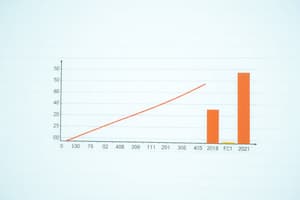Podcast
Questions and Answers
What is a primary purpose of regression analysis?
What is a primary purpose of regression analysis?
- To collect data through surveys
- To increase the number of independent variables
- To summarize data into a visual format
- To predict the relationship between independent and dependent variables (correct)
Which of the following statements about the coefficient of correlation (r) is true?
Which of the following statements about the coefficient of correlation (r) is true?
- It measures the best fitting curve's slope
- It indicates the quantity of data collected
- It is the square root of the amount of variance explained by the curve (correct)
- It defines the independent variables in a regression model
In a regression model, what is the dependent variable (DV)?
In a regression model, what is the dependent variable (DV)?
- A variable that remains constant throughout the analysis
- A variable that is plotted on the X-axis
- The outcome variable that is being predicted (correct)
- A variable that explains changes in other variables
What is an example of a potential disadvantage of using regression?
What is an example of a potential disadvantage of using regression?
What type of regression is typically used for predicting binary outcomes?
What type of regression is typically used for predicting binary outcomes?
During the pizza sales data collection experiment, the environmental factor being examined is primarily aimed at studying how which of the following affects sales?
During the pizza sales data collection experiment, the environmental factor being examined is primarily aimed at studying how which of the following affects sales?
In the context of regression, what does R2 represent?
In the context of regression, what does R2 represent?
What was one of Nate Silver's notable achievements in political forecasting?
What was one of Nate Silver's notable achievements in political forecasting?
What is the range of the correlation coefficient (r)?
What is the range of the correlation coefficient (r)?
In the regression equation $y = β0 + β1 x + ε$, what does 'y' represent?
In the regression equation $y = β0 + β1 x + ε$, what does 'y' represent?
Which of the following best describes a scatter plot?
Which of the following best describes a scatter plot?
What does a correlation of 1 indicate?
What does a correlation of 1 indicate?
When categorizing variables, what does correlation help to determine?
When categorizing variables, what does correlation help to determine?
Which of the following statements about correlation is false?
Which of the following statements about correlation is false?
What is the coefficient of correlation between house price and size?
What is the coefficient of correlation between house price and size?
What is the primary purpose of a regression model?
What is the primary purpose of a regression model?
If two variables have a correlation coefficient of 0.5, what can be inferred?
If two variables have a correlation coefficient of 0.5, what can be inferred?
What percentage of variance in house prices is explained by the equation with size as the only predictor?
What percentage of variance in house prices is explained by the equation with size as the only predictor?
Which variable has the strongest correlation with the house price among the listed predictors?
Which variable has the strongest correlation with the house price among the listed predictors?
What is the equation for predicting house prices when both size and number of rooms are included as predictors?
What is the equation for predicting house prices when both size and number of rooms are included as predictors?
What is the R² value when the regression model includes both size and number of rooms?
What is the R² value when the regression model includes both size and number of rooms?
Which of the following statements is true about the regression coefficients?
Which of the following statements is true about the regression coefficients?
What effect does adding the number of rooms as a predictor have on the regression model?
What effect does adding the number of rooms as a predictor have on the regression model?
How much of the variance in house prices remains unexplained when using both size and number of rooms?
How much of the variance in house prices remains unexplained when using both size and number of rooms?
What issue arises when independent variables in a regression model exhibit strong linear correlations?
What issue arises when independent variables in a regression model exhibit strong linear correlations?
Which of the following statements is true regarding regression models and collinearity?
Which of the following statements is true regarding regression models and collinearity?
What type of variable should a regression model be used to predict?
What type of variable should a regression model be used to predict?
How do regression models typically handle non-linearity?
How do regression models typically handle non-linearity?
Which of the following is NOT true about regression models?
Which of the following is NOT true about regression models?
What type of variables does logistic regression typically work with for the dependent variable?
What type of variables does logistic regression typically work with for the dependent variable?
Which of the following best describes the logit in logistic regression?
Which of the following best describes the logit in logistic regression?
Which is NOT an advantage of regression models?
Which is NOT an advantage of regression models?
What is the primary purpose of logistic regression?
What is the primary purpose of logistic regression?
How do regression models measure the strength of fit?
How do regression models measure the strength of fit?
Which of the following is a possible disadvantage of regression models?
Which of the following is a possible disadvantage of regression models?
In the context of logistic regression, what does the dependent variable typically represent?
In the context of logistic regression, what does the dependent variable typically represent?
Which regression technique is noted for its ability to handle various statistical packages?
Which regression technique is noted for its ability to handle various statistical packages?
What is the predicted house price for a house that is 2000 square feet and has 3 bedrooms?
What is the predicted house price for a house that is 2000 square feet and has 3 bedrooms?
Which indicates a weak fit for a regression model based on its R-squared value?
Which indicates a weak fit for a regression model based on its R-squared value?
How does introducing a quadratic variable like Temp2 affect the regression model?
How does introducing a quadratic variable like Temp2 affect the regression model?
What is the new equation for predicting energy consumption with the quadratic term included?
What is the new equation for predicting energy consumption with the quadratic term included?
What does an R-squared value of 0.985 indicate about the variables in the regression model?
What does an R-squared value of 0.985 indicate about the variables in the regression model?
When temperature is 72 degrees, what information is needed to calculate the Kwatts value?
When temperature is 72 degrees, what information is needed to calculate the Kwatts value?
What does the coefficient 15.87 represent in the energy consumption equation?
What does the coefficient 15.87 represent in the energy consumption equation?
What is the consequence of a scatter plot showing a poor fit for the temperature and Kwatts relationship?
What is the consequence of a scatter plot showing a poor fit for the temperature and Kwatts relationship?
Flashcards
Regression analysis
Regression analysis
A statistical technique to predict the relationship between one or more independent variables and a dependent variable.
Independent variable
Independent variable
A variable in a regression analysis whose value is changed to see how it affects the dependent variable.
Dependent variable
Dependent variable
A variable in a regression analysis whose value is predicted or explained by the independent variable(s).
Coefficient of correlation (r)
Coefficient of correlation (r)
Signup and view all the flashcards
R-squared (R²)
R-squared (R²)
Signup and view all the flashcards
Linear regression
Linear regression
Signup and view all the flashcards
Supervised learning
Supervised learning
Signup and view all the flashcards
Nate Silver
Nate Silver
Signup and view all the flashcards
Hypothesis Development
Hypothesis Development
Signup and view all the flashcards
Data Analysis
Data Analysis
Signup and view all the flashcards
Correlation Coefficient (r)
Correlation Coefficient (r)
Signup and view all the flashcards
Positive Correlation
Positive Correlation
Signup and view all the flashcards
Negative Correlation
Negative Correlation
Signup and view all the flashcards
Scatter Plot
Scatter Plot
Signup and view all the flashcards
Regression Equation
Regression Equation
Signup and view all the flashcards
Independent Variable (x)
Independent Variable (x)
Signup and view all the flashcards
Predicting House Price
Predicting House Price
Signup and view all the flashcards
Evaluating Model Accuracy
Evaluating Model Accuracy
Signup and view all the flashcards
Non-linear Regression
Non-linear Regression
Signup and view all the flashcards
Electricity Consumption Prediction
Electricity Consumption Prediction
Signup and view all the flashcards
Curvilinear Relationship
Curvilinear Relationship
Signup and view all the flashcards
Quadratic Variable
Quadratic Variable
Signup and view all the flashcards
Logistic Regression
Logistic Regression
Signup and view all the flashcards
Logit
Logit
Signup and view all the flashcards
Advantages of Regression Models
Advantages of Regression Models
Signup and view all the flashcards
Disadvantages of Regression Models
Disadvantages of Regression Models
Signup and view all the flashcards
Correlation Coefficient
Correlation Coefficient
Signup and view all the flashcards
Regression Model
Regression Model
Signup and view all the flashcards
Regression Coefficient
Regression Coefficient
Signup and view all the flashcards
Predictor Variable
Predictor Variable
Signup and view all the flashcards
Strong Correlation (Regression)
Strong Correlation (Regression)
Signup and view all the flashcards
Collinearity
Collinearity
Signup and view all the flashcards
Regression Model Pruning
Regression Model Pruning
Signup and view all the flashcards
Non-linearity in Models
Non-linearity in Models
Signup and view all the flashcards
Categorical Data in Regression
Categorical Data in Regression
Signup and view all the flashcards
Regression vs. Classification
Regression vs. Classification
Signup and view all the flashcards
Study Notes
Regression Overview
- Regression is a statistical method used to predict the relationship between several independent variables and one dependent variable.
- It's a supervised learning technique that aims to find the best-fitting curve (linear or non-linear) for a dependent variable within a multi-dimensional space.
- The quality of fit is measured by the coefficient of correlation (r) and the R² value.
- R² represents the variance explained by the curve, and r is the square root of the explained variance.
Learning Objectives
- Understand the concept of regression
- Learn how to implement regression in Excel.
- Improve regression model prediction accuracy.
- Define and discuss logistic regression.
- Evaluate the pros and cons of the regression method.
- Practice performing regression in Excel.
What is Regression?
- Regression is a well-known statistical technique to predict the relationship between several independent and one dependent variable.
- It's a supervised machine learning approach.
- A model can be created by determining an equation.
- The equation often uses one or more predictor variables (independent variables) and a single target variable or dependent variable.
- The equation describes how the dependent variable is expected to change in response to changes in the independent variables.
How Much to Produce?
- Example scenario: A pizza business needs to determine daily dough production based on weather patterns and sales history.
- Various factors influence sales.
- The scenario involves collecting data (temperature and sales) over the summer to create a model.
- The goal is to create a model that can predict how much dough is needed based on the temperature and historical sales.
Key Steps for Regression
- List all accessible attributes.
- Select the target dependent variable .
- Graph/visually review relationships between variables.
- Create an equation to predict the target variable using other attributes.
Case Study: Data Driven Prediction
- Nate Silver, a data-driven political forecaster, used big data and advanced analytics to predict election outcomes, with successful predictions in Presidential and Senate elections.
- His methodology focuses on developing hypotheses, gathering data, analyzing it with sophisticated models and algorithms to produce insightful results.
Correlations and Relationships
- Categorize variables having relationships (correlated) and unrelated ones.
- Correlation measures the strength of a relationship.
- The correlation coefficient (r) ranges from -1 to +1.
- A correlation of 0 indicates no relationship; +1 means a perfect positive relationship, and -1 means a perfect negative relationship.
Visual Look at Relationships
- Scatter plots visualize the relationship between two variables.
- Each point on the plot represents a data point.
- Scatter plots help to visually identify trends or patterns in the data.
- Scatterplots help to determine if the correlation is linear and the strength of the relationship between variables.
- Scatterplots show linear and non-linear relationships.
Regression Exercise
- The regression equation is represented as a straightforward equation (y = β0 + β1x + ε).
- y is the variable being predicted, which is also referred to as the dependent variable.
- x is the independent or predictor variable
- The regression model can include many predictor variables (x1, x2,…).
- The regression equation has one and only one dependent variable (y).
House Data
- Example scenario: Predicting house prices based on size (predictor) using a scatter plot. A positive correlation exists between house price and area. This is not a perfect correlation.
Correlation and Regression
- Example: A correlation of 0.891 between house size and price suggests a strong positive relationship.
- An R² value of 0.794 suggests the model explains approximately 79.4% of the variance in house prices.
- Regression equations can be formed based on the calculated coefficients.
- Example equation: House Price ($) = 139.48 * Size(sqft) – 54191
House Data (Correlation and Regression)
- Adding other variables like the number of rooms leads to a stronger predictive model.
- The variables in this data are positively and strongly correlated (e.g., 0.984 correlation coefficient, 0.968 R²).
- The added variable increases the predictive power of the model.
Predict the House Price
- Generate a predictive equation using the calculated regression coefficients.
- Example: House Price ($) = 65.6 * Size(sqft) + 23613 * Rooms + 12924
Non-Linear Regression Exercise
- The scenario illustrates the situation where a non-linear relationship exists between variables (e.g., temperature related electricity consumption data).
- A linear model fits poorly.
- Applying a quadratic term (i.e., Temp²) provides a strong linear relationship which significantly improves the accuracy.
- Using a quadratic term (Temp²) provides a significant improvement and results in a high R² value (near 1) for the model which indicates a strong correlation.
Predict Energy Consumption
- Calculate the energy consumption given temperature levels using the updated regression equation.
- The new equation has a strong positive correlation with the target variable, with R² approaching 1.
- Example: "Energy Consumption = 15.87 * Temp² -1911 * Temp + 67245".
Logistic Regression
- Regression models typically work with continuous numerical data.
- Logistic regression uses binary (yes/no) values for the target variable.
Logistic Regression (cont'd)
- Logistic Regression models use probability scores.
- A logit (natural logarithm of the odds) function is used.
- The model provides a continuous criterion.
- This type of regression is used to predict the binary outcome of an event from a combination of independent variables.
Advantages of Regression Models
- Easy to comprehend and use.
- Based on established statistical principles.
- Simple equations.
- Useful for predicting outcomes of other modeling techniques.
- Enables inclusion of multiple variables in the model.
- Easy to implement.
Disadvantages of Regression Models
- Sensitive to data quality (missing data, errors, non-normal distributions).
- Affected by high correlations between predictors.
- Overly sensitive to adding too many independent variables (collinearity).
- Data must be numerical and doesn't easily accommodate categorical variables.
- Cannot automatically handle non-linear relationships.
Which Technique to Use?
- Choose regression for continuous target variables.
- Choose classification for discrete target variables (e.g., yes/no, categories).
In Class Exercise
- Create a regression model to predict Test 2 scores from Test 1 score
- Predict a student's Test 2 score who scored 46 on Test 1.
- Identify the dependent variable (Test 2 score).
- Identify input variables (Test 1 score).
Studying That Suits You
Use AI to generate personalized quizzes and flashcards to suit your learning preferences.




